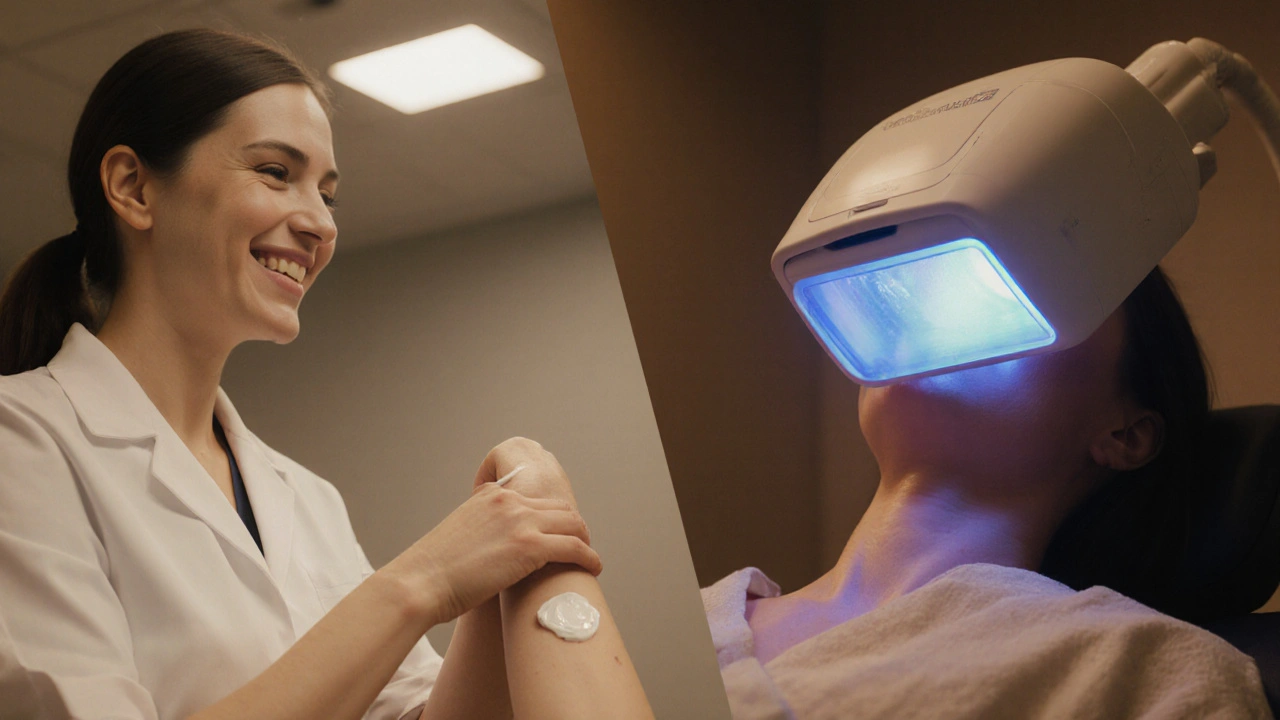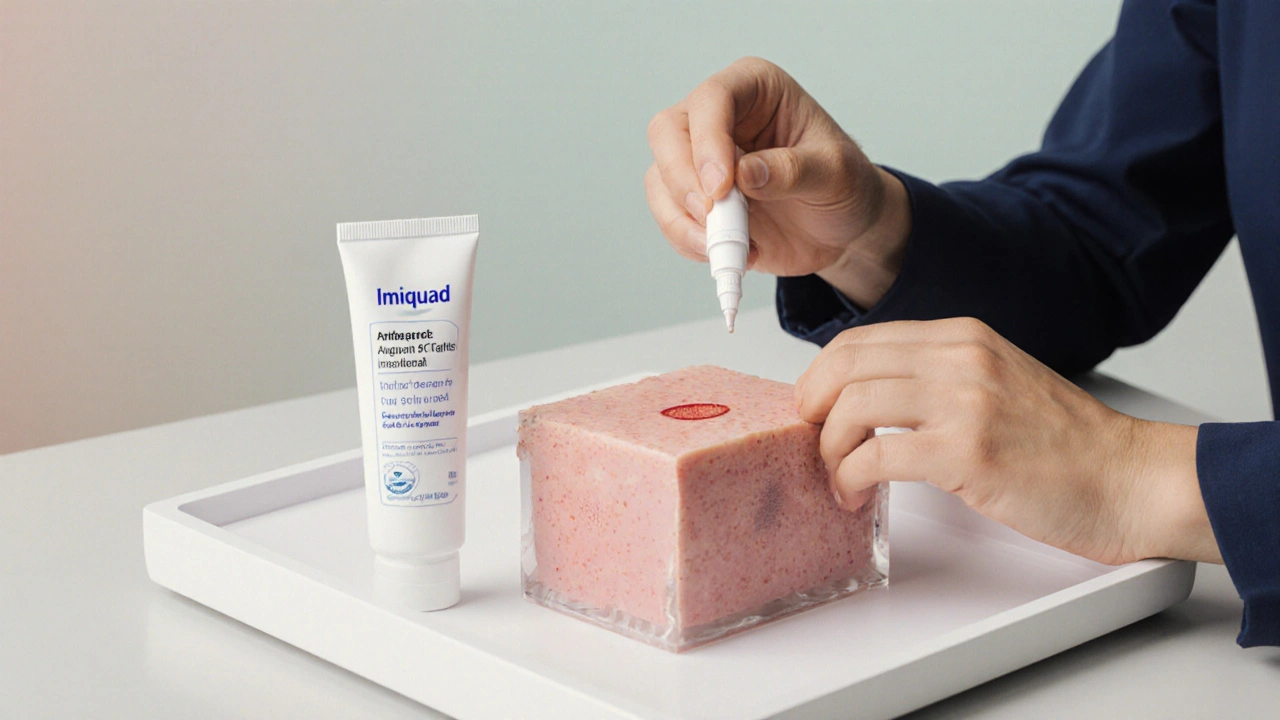Topical Skin Lesion Treatment Selector
Select Your Condition
Skin Sensitivity Level
Time Commitment
Budget Consideration
Dealing with stubborn skin lesions-whether it’s actinic keratosis, genital warts, or a superficial basal cell carcinoma-can feel overwhelming. You’ve probably heard about Imiquad cream and wonder if it’s truly the right fit or if other options might work better for your skin type, budget, or lifestyle.
Quick Takeaways
- Imiquad (imiquimod) triggers your immune system; it’s great for viral‑induced warts but can irritate sensitive skin.
- 5‑Fluorouracil cream directly destroys abnormal cells, ideal for extensive actinic keratoses but often causes painful redness.
- Diclofenac sodium gel works slowly with milder side effects, making it a gentler option for field‑treated actinic keratosis.
- Procedural alternatives like photodynamic therapy or cryotherapy provide quick results but require clinic visits.
- Cost, treatment duration, and side‑effect tolerance are the three biggest decision points.
What Is Imiquad Cream?
Imiquad Cream is a prescription‑only topical immunomodulator containing the active ingredient imiquimod. Approved in the UK for treating genital warts, actinic keratosis, and superficial basal cell carcinoma, it works by stimulating the body’s innate immune response to target abnormal cells.
How Imiquad Works
Imiquimod binds to Toll‑like receptor 7 (TLR‑7) on immune cells, prompting the release of cytokines such as interferon‑α, tumour necrosis factor‑α, and interleukins. This cascade ramps up local immune activity, which helps clear virus‑infected or pre‑cancerous cells. Because it relies on the immune system, the treatment period can be lengthy-typically 4weeks for genital warts and up to 16weeks for actinic keratosis.

Topical Alternatives Worth Considering
Aldara is essentially the same active ingredient (imiquimod) but marketed under a different brand name. The formulation and dosing schedule are identical, so the choice often boils down to price or pharmacy availability.
5‑Fluorouracil Cream (often sold as Efudex or Carac) is a topical chemotherapy agent. It directly interferes with DNA synthesis in rapidly dividing cells, causing cell death. It’s particularly effective for widespread actinic keratosis but frequently induces burning, crusting, and intense erythema.
Diclofenac Sodium Gel (e.g., Solaraze) is a non‑steroidal anti‑inflammatory drug formulated for skin. It inhibits cyclo‑oxygenase enzymes, reducing inflammation and promoting apoptosis of abnormal cells. Treatment lasts 2-3months, and side effects are usually mild redness or itching.
Photodynamic Therapy (PDT) combines a photosensitizing cream (often aminolevulinic acid) with a specific light source. After applying the cream, the area is illuminated, activating reactive oxygen species that destroy abnormal cells. PDT offers rapid clearance-often within a single session-but requires a clinic visit and can cause temporary swelling and discoloration.
Cryotherapy freezes lesions with liquid nitrogen. It’s a quick, office‑based procedure suitable for isolated warts or keratoses. While effective, it may lead to hypopigmentation and needs repeat treatments for larger fields.
Side‑Effect Profile Snapshot
| Product | Primary Indication | Mechanism | Treatment Duration | Common Side Effects | Typical Cost (UK) |
|---|---|---|---|---|---|
| Imiquad | Genital warts, actinic keratosis, superficial BCC | TLR‑7 immune activation | 4‑16weeks (depends on lesion) | Redness, itching, flu‑like symptoms | ≈£60‑£80 per tube |
| 5‑Fluorouracil | Actinic keratosis, superficial BCC | DNA synthesis inhibition | 2‑4weeks | Severe burning, crusting | ≈£45‑£65 per tube |
| Diclofenac Gel | Actinic keratosis (field therapy) | COX inhibition → apoptosis | 2‑3months | Mild irritation, occasional itching | ≈£30‑£50 per tube |
| Photodynamic Therapy | Actinic keratosis, superficial BCC | Photosensitizer + light → ROS | Single‑day procedure (may repeat) | Temporary redness, swelling | ≈£150‑£250 per session |
| Cryotherapy | Warts, isolated keratoses | Extreme cold → cellular destruction | Minutes (clinic visit) | Possible hypopigmentation | ≈£30‑£60 per treatment |
Choosing the Right Treatment for You
- Lesion type and extent: For a few localized warts, Imiquad or cryotherapy works well. For a large field of actinic keratoses, 5‑Fluorouracil or diclofenac may be more efficient.
- Skin sensitivity: If your skin burns easily, avoid 5‑Fluorouracil and consider diclofenac or Imiquad (which tends to cause milder inflammation).
- Time commitment: Clinic‑based options (PDT, cryotherapy) offer quick clearance. Topical creams require daily self‑application for weeks or months.
- Cost considerations: Over a 3‑month period, Imiquad and 5‑Fluorouracil are similarly priced, while diclofenac is cheaper but takes longer. Procedural therapies have higher upfront costs.
- Medical history: Patients with autoimmune disorders should discuss Imiquad with a dermatologist, as boosting immune activity could flare underlying conditions.
Practical Tips to Maximise Success
- Follow the prescribed application schedule exactly-missed doses can reduce efficacy.
- Apply a thin layer to clean, dry skin; avoid surrounding healthy tissue to limit irritation.
- Use a moisturizer or barrier cream (e.g., zinc oxide) after the treatment window if your skin feels tight.
- Track side effects in a diary; report severe pain or ulceration to your GP immediately.
- Schedule a follow‑up appointment after the course ends to confirm lesion clearance.

Frequently Asked Questions
Can I use Imiquad and 5‑Fluorouracil together?
No. Both drugs are potent and work via different mechanisms. Using them together raises the risk of severe skin reactions without proven added benefit. Choose one based on your dermatologist’s recommendation.
How long does it take to see results with Imiquad?
Visible improvement often appears after 2‑3weeks, but full clearance can take up to the complete treatment duration (4-16weeks). Patience is key.
Is Imiquad safe during pregnancy?
Imiquimod is classified as Category B in the UK, meaning animal studies haven’t shown risk but human data are limited. Discuss alternatives with your obstetrician before use.
What should I do if I develop severe redness?
Stop application immediately and contact your dermatologist. Often a short break or a reduced frequency can mitigate irritation.
Are there over‑the‑counter options similar to Imiquad?
No. Imiquimod is prescription‑only because of its immune‑activating properties. Over‑the‑counter salicylic acid or podophyllotoxin preparations exist for warts, but they work differently and have distinct efficacy profiles.


Burl Henderson
When you’re parsing the therapeutic landscape for cutaneous lesions, the pharmacodynamics of imiquimod deserve a deep dive. Its TLR‑7 agonism essentially flags the local immune milieu, which can be a double‑edged sword for patients with delicate epidermal barrier function. That said, the cost‑benefit ratio often hinges on lesion burden and patient compliance, especially compared to the kinetic profile of 5‑FU. In practice, I find clinicians gravitate toward a mixed regimen-starting with diclofenac for field therapy and reserving imiquimod for isolated warts. Ultimately, the decision matrix is a blend of efficacy, tolerability, and budget constraints.